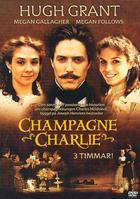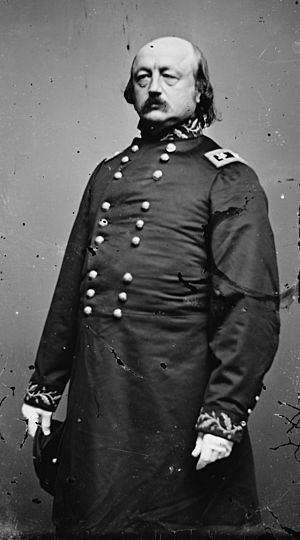Charles Heidsieck facts for kids
Charles Camille Heidsieck (1822–1893) was a French businessman. He started his own Champagne company, Charles Heidsieck, in 1851. He helped make Champagne popular in the United States. People even called him "Champagne Charlie" because of this.
During the American Civil War, he was held in prison. This happened because some thought he was a spy for the French government and the Confederacy. His time in prison caused a big problem between France and the US, known as the Heidsieck Incident.
Contents
Who Was Charles Heidsieck?
A Family of Champagne Makers
Charles Heidsieck came from a family famous for making Champagne. His father, Charles-Henri Heidsieck, was also a Champagne merchant. There's a story that in 1811, his father rode into Moscow on a white horse. This was just before Napoleon's army arrived. He brought Champagne and was ready to celebrate with whoever won the battle.
Charles Heidsieck's great-uncle, Florens-Louis Heidsieck, helped start the Champagne house that later became Piper-Heidsieck. His cousins also founded another well-known Champagne company, Heidsieck & Co Monopole. Charles Camille Heidsieck was married to Amélie Henriot.
Becoming "Champagne Charlie"
In 1852, Charles Heidsieck visited the United States for the first time. He traveled around New England and New York State. He quickly saw that Americans would love his Champagne. He hired someone to help him sell it there.
His Champagne became very popular, and sales were huge. When he returned five years later, New York City gave him a big welcome. Newspapers wrote about him, and parties were held in his honor. On this trip and others, he became known as Champagne Charlie. He was a popular figure in New York's high society.
Challenges During the American Civil War
Trouble with Unpaid Debts
In 1861, Charles Heidsieck heard about the American Civil War starting. More than half of his company's money was stuck in unpaid bills in the US. So, Heidsieck quickly left Reims, France, and sailed to America.
When he arrived, his sales agent told him about a new law. This law meant people in the North didn't have to pay for cotton bought from the South. It also meant the agent didn't have to pay his debt to Heidsieck.
A Risky Trip South
With no other choice, Charles Heidsieck decided to go to New Orleans. He hoped to get paid directly from the merchants who received his Champagne. Because of the war, he had to travel secretly into the South. He even went as far as Kansas to avoid being caught by the Union Army.
He arrived in April 1862. He found New Orleans was almost broke and couldn't pay its debts. However, one merchant had a warehouse full of cotton. Cotton was in high demand in Europe because the Union blockade stopped it from leaving the South. Heidsieck took the cotton as payment. He tried to sneak it out of the port in Mobile, Alabama using two blockade runners. He told the ships to take different routes, hoping at least one would get through. But both ships were stopped and sunk, and all the cotton was lost.
Imprisonment and Release
By this time, all routes to the North were closed. So Heidsieck went to New Orleans. He tried to find a boat to Mexico or Cuba to get back to Europe. The French consul in Mobile gave him a special diplomatic bag. Heidsieck was asked to deliver some documents to the consulate in New Orleans.
He arrived in New Orleans on May 5, 1862. He found that the city had been taken over by Union forces. He was immediately arrested by General Benjamin F. Butler. Inside the diplomatic bag were documents from French fabric makers. These papers were about supplying uniforms to the Confederate armies. Even though Heidsieck said he knew nothing about the documents, he was accused of being a spy. He was then put in prison at Fort Jackson, Louisiana.
Charles Heidsieck's imprisonment caused a big problem between the French and US governments. This was called the Heidsieck Incident. French diplomats and even Napoleon III contacted President Abraham Lincoln. They asked for Heidsieck to be released. He was finally set free on November 16, 1862. By then, he was very sick. His business was bankrupt, and his wife was selling family property to pay his debts. Heidsieck returned to France feeling sad and broke.
A Great Comeback

In early 1863, an American missionary visited Charles Heidsieck. He brought some papers and a letter from the United States. The letter was from the brother of Heidsieck's old agent in New York. The brother felt bad about how Heidsieck had been treated. He offered Heidsieck a stack of deeds to land in Colorado as a way to repay him.
It turned out that these deeds were for land that made up a third of Denver. At the time, Denver was a small village. But it soon grew into one of the largest and richest cities in the American West. After a few years, Heidsieck was able to sell the land. He used the money to pay off all his debts. With the extra money, he was able to restart his Champagne company. He quickly made it one of Champagne's top businesses again.
Charles Heidsieck in Media
In 1989, a French-Canadian television movie called Champagne Charlie told Heidsieck's life story. The English actor Hugh Grant played Charles Heidsieck in the film.



